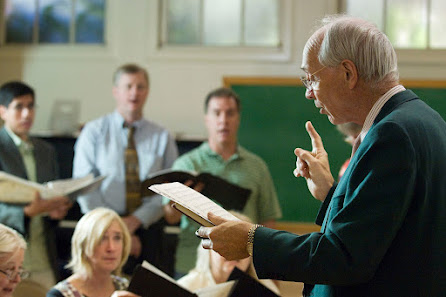
In this blog is an assortment of information about the front page SFChronicle article yesterday about Prof. Mahrt and the St. Ann choir.
The attachment is one of the photos you can see at sfgate.com (link further down). Nice photo. It's a bit odd, though, that Susan Altstatt got included as one of the tenors!
You can listen to the podcast, including more quotes from the interview that didn't get into the article and singing at Chronicle Radio:
http://www.sfgate.com/cgi-bin/blogs/sfgate/detail?blogid=5&entry_id=22826
In the interest of musical fellowship.
Roseanne
----------------------------------------------------------------------
This article was sent to you by someone who found it on SFGate.
The original article can be found on SFGate.com here:
http://www.sfgate.com/cgi-bin/article.cgi?file=/c/a/2007/12/23/MN5MTKOJN.DTL
---------------------------------------------------------------------
Sunday, December 23, 2007 (SF Chronicle)
Stanford professor's Palo Alto choir keeps Gregorian chant alive
Carrie Sturrock, Chronicle Staff Writer
Gregorian chant has persisted for more than a thousand years, but some
fear the haunting melodies are in danger of fading away.
That is, unless Stanford Professor William Mahrt has a voice in the
matter. For the past 44 years, this musician and scholar has directed a
choir to keep alive the medieval Catholic tradition he believes is a
pathway to the sacred and divine.
"When you sing it beautifully and when it really works, there's an
absolute still in the church," he said. "That's the kind of silence that's
fruitful and it represents a kind of self-awareness that is also aware of
the wider realities, and that kind of silence is where you have your best
opportunity to speak to God and to listen to God."
It hasn't always been easy. Gregorian chant calls to mind robed monks
singing Latin in a Gothic cathedral, and for hundreds of years that's
exactly what it looked like. Many in the church considered the sonorous
chant a relic and Mahrt's choir odd.
"Sometimes we were treated like a lunatic fringe," said Susan Altstatt,
who has sung in Mahrt's choir in Palo Alto for 40 years. "A lot thought we
were not very 'with it' - as far as being part of the modern church - and
hoped we would eventually dry up and blow away."
But Mahrt, 68, is not just deeply religious, he's also stubborn. He
considers Gregorian chant one of the greatest artistic achievements of
Western civilization. So it's in everyone's best interest to keep it
around - Catholic or no.
"The stuff is so unique that you hear a snatch of it and you say 'What is
that?' " Mahrt said. "It isn't like anything else you've heard."
On a recent Sunday, he stood in the balcony of St. Thomas Aquinas Church
in Palo Alto, his tall, slightly bent frame directing the 20 men and women
- known as the St. Ann Choir - whose chanting seemed at times to have a
mesmerizing effect on the congregation, making everything tranquil and
quiet.
"Dignus est agnus, qui occisus est/ accipere virtutem, et divinitatem, et/
sapientiam, et fortitudinem, et honorem."
"Worthy is the lamb that was slain to receive power, and divinity, and
wisdom, and strength, and honor."
Chanting was common in churches across the world until the early 1960s,
when the Second Vatican Council permitted the Latin Mass to be said in the
vernacular and the priest to face the congregation instead of the altar.
Chant got the boot as churches turned to pop folk music to try to appeal
to a broader audience - music Mahrt says he "wouldn't cross the street" to
listen to. Priests who valued the chant yet didn't use it during Mass have
told Mahrt they feared modern congregations wouldn't get it. But Mahrt
contends that chant is accessible if people are properly introduced to it
and persuaded of its worth.
Now, most folks hear it only occasionally - in movies such as "Becket" or
if they happen to hear recordings by the Benedictine Monks of Santo
Domingo de Silos, who made it briefly popular.
And although Pope Benedict XVI recently announced that the Vatican's choir
would return to Gregorian chant, Mahrt still worries. There aren't many
Gregorian chant choirs in the United States and even fewer that have done
what Mahrt's has: rehearsed and chanted the entire Mass every week for
more than four decades.
Gregorian chant is Latin liturgical texts sung in an unaccompanied melody
- so no instruments. Many scholars believe it dates back to fourth century
Jerusalem, although nothing was written down until the ninth century. For
500 years it endured through memory, which Mahrt considers astonishing
since the chant involves 365 days of the Catholic liturgical cycle. It's
called "Gregorian" because legend has it Pope St. Gregory I, the Great
(540-604), played a key role in arranging the chants.
The chants may be ancient, but Mahrt's motley crew of a choir looks
decidedly modern, wearing everything from Birkenstocks and tie-dye to high
heels and suits. Mahrt would love to spiff them up with robes, but the
suggestion never seems to go anywhere. And not everyone is Catholic - some
chant for the sheer joy of it.
Many view Mahrt as something of a hero, said choir member Roseanne
Sullivan. In an age of instant, ever-changing entertainment, his
dedication hasn't wavered. The confirmed bachelor shows up almost without
fail, always in a tie and jacket, and with a large store of patience. When
he's not there and a substitute choir director takes his place, it's often
because he's promoting chant in other parts of the country and world.
"He's shown up year after year and week after week ... for 44 years," she
said. "Can you imagine?"
Mahrt, an associate professor of music, began his undergraduate education
at Gonzaga University in Spokane, Wash., but graduated from the University
of Washington. He then earned his doctorate at Stanford. Friends say he's
one of the world's foremost authorities on Gregorian chant and one of
Stanford's best music professors.
He guides his graduate students deep into their intellectual arguments
until they've mastered the material and "will invest an almost
unbelievable amount of time into things," said George Houle, a Stanford
professor emeritus. Mahrt has been slow to publish in an academic world
that highly values that practice because, as Houle put it, "everything he
does has that deep perfection and thought" and he wants to own a subject
before writing about it.
Much of his spare income goes to collecting books on Gregorian chant, and
he had to specially brace his extra bedroom's floor when he turned it into
a library with stacks. Friends say his collection, which includes a 14th
century chant book that he likes to show visitors, is more extensive than
Stanford's.
Nothing about his upbringing on a wheat farm in Spokane exposed him to
Gregorian chant, but he did have a devoutly religious mother who required
all her children to take up a musical instrument in the third grade. It
wasn't until Mahrt was an undergraduate at the University of Washington
that he was introduced to Gregorian chant by a Dominican priest in the
community.
He likes to say that someone once defined the sacred as "doing the right
thing at the right time and in the right place." Gregorian chant is just
that, he said: putting to music all these Latin liturgical texts that form
the backbone of the Catholic faith.
"It adds something beautiful," he said. "A religious service ... should be
beautiful because beauty is an attribute of God."
-- To hear the St. Ann Choir perform Gregorian chant, go to
sfgate.com/podcasts.
The St. Ann Choir will chant the Christmas Eve midnight Mass as well as
the Christmas Day noon Mass at St. Thomas Aquinas Church. The church is
located at 751 Waverley St., Palo Alto.
E-mail Carrie Sturrock at csturrock@sfchronicle.com. ----------------------------------------------------------------------
Copyright 2007 SF Chronicle












.jpg)













